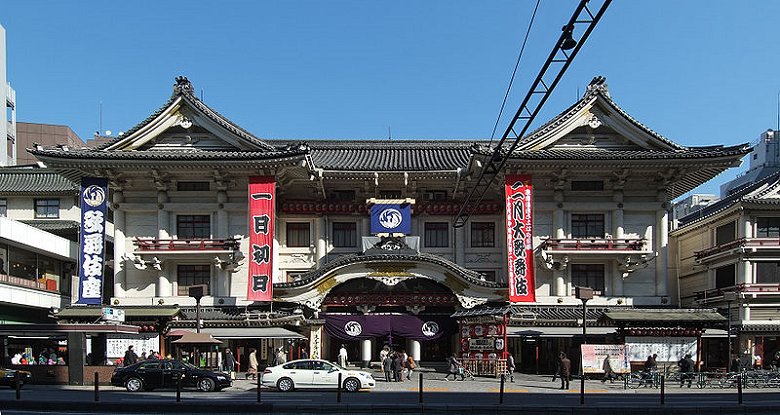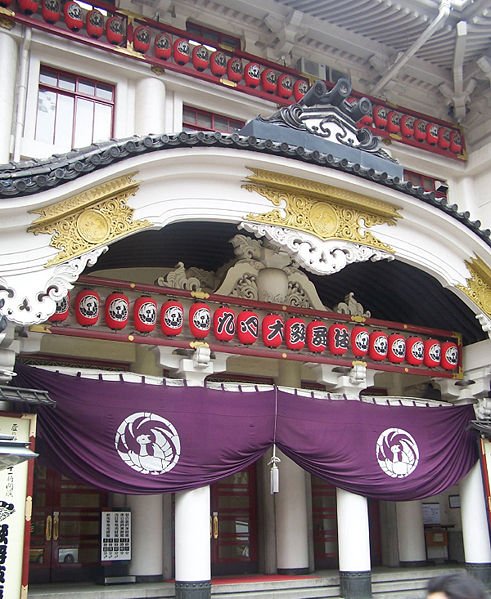 Kabuki-za Theater
Kabuki-za TheaterSource: http://commons.wikimedia.org/wiki/File:Kabuki-za_theater_2010.jpg
Author: Wiiii

Author: Wiiii

Kabuki-za is the main theatre in Tokyo where Kabuki dramas are performed. Located in the Ginza district, Kabuki-za opened in 1889. At that time, it was a splendid example of an eclectic mix of Western materials with Japanese architectural style that best represents Meiji-era construction. It was originally intended to be the residence of the Kumamoto clan.
 Entrance of the Kabukiza before the reconstruction
Entrance of the Kabukiza before the reconstructionSource: http://commons.wikimedia.org/wiki/File:Kabuki-za_front_cropped.jpg
Author: Melanom

The Kabuzi-ka of 1889 had long gone, having been destroyed in a fire in 1921. While a new Kabuki-za was under construction, the Great Kanto Earthquake struck, causing massive destruction. It was eventually completed in 1924, in the Japanese revivalist style, modelled after Japanese castles of the 16th century. But it was destroyed under Allied bombings during the Second World War. What we see today is the Kabuki-za that was built after the war. It is modelled after the 1924 structure.
Kabuki dramas are performed daily at the Kabuki-za, and tickets are available for both individual acts as well as for entire plays. These individual acts tickets are sold so that audiences can get a feel whether or not they want to sit through the whole play.
Kabuki is a form of pantomime, Japanese style, combining dance, traditional music and humor. However, I suppose one has to understand Japanese (or rather, understand the Japanese) sufficiently in order to appreciate Kabuki.
Ginza, Chuo-ku
Tel: 81-3-3541-3131
Opening Times:
Matinees: 11:00am-3:45pm
Evening shows: 4:30pm-9:00pm
Looking for information on Penang? Use this Map of Roads in Penang to zoom in on information about Penang, brought to you road by road.

Author: Melanom

The Kabuzi-ka of 1889 had long gone, having been destroyed in a fire in 1921. While a new Kabuki-za was under construction, the Great Kanto Earthquake struck, causing massive destruction. It was eventually completed in 1924, in the Japanese revivalist style, modelled after Japanese castles of the 16th century. But it was destroyed under Allied bombings during the Second World War. What we see today is the Kabuki-za that was built after the war. It is modelled after the 1924 structure.
Kabuki dramas are performed daily at the Kabuki-za, and tickets are available for both individual acts as well as for entire plays. These individual acts tickets are sold so that audiences can get a feel whether or not they want to sit through the whole play.
Kabuki is a form of pantomime, Japanese style, combining dance, traditional music and humor. However, I suppose one has to understand Japanese (or rather, understand the Japanese) sufficiently in order to appreciate Kabuki.
2010 Update
Concerns over the theater's ability to survive earthquakes as well as accessibility issues compelled the Kabuki-za to be demolished. A new Kabuki-za is expected to be rebuilt and will be ready by 2013. Until then, Kabuki performances will be held at the nearby Shinbashi Enbujo theater.Kabuki-za Tourist Information
Kabuki-zaGinza, Chuo-ku
Tel: 81-3-3541-3131
Opening Times:
Matinees: 11:00am-3:45pm
Evening shows: 4:30pm-9:00pm
Getting there
The Higashi-ginza Station (A11, H09), Entrance 3 is located right in front of Kabuki-za. Latest updates on Penang Travel Tips
Latest updates on Penang Travel Tips
 Map of Roads in Penang
Map of Roads in Penang
Looking for information on Penang? Use this Map of Roads in Penang to zoom in on information about Penang, brought to you road by road.
Copyright © 2003-2025 Timothy Tye. All Rights Reserved.

 Go Back
Go Back